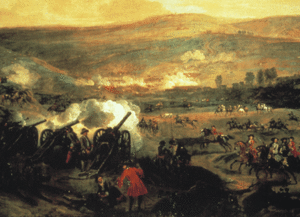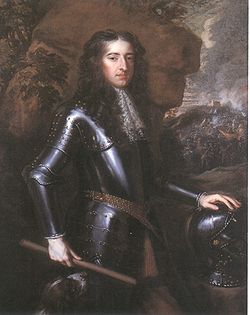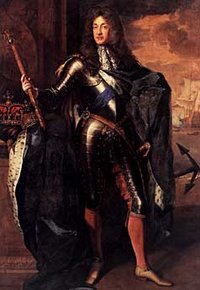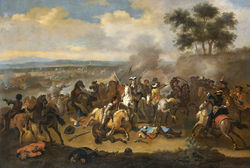Battle of the Boyne
| Battle of the Boyne | |||||||
|---|---|---|---|---|---|---|---|
| Part of the Williamite War in Ireland | |||||||
 Painting of the battle by Jan Wyck c. 1693 |
|||||||
|
|||||||
| Belligerents | |||||||
| Jacobite forces | Williamite forces | ||||||
| Commanders and leaders | |||||||
| James VII and II | William III of Orange | ||||||
| Strength | |||||||
| 25,000, including: -19,000 Irish Catholics -6,000 French |
36,000 | ||||||
| Casualties and losses | |||||||
| ~1,500 casualties | ~750 casualties | ||||||
|
|||||

King of England, Scotland and Ireland, Stadtholder of the Netherlands
The Battle of the Boyne (Irish: Cath na Bóinne, IPA: [ˈkah n̪ˠə ˈbˠoːn̪ʲə]) was fought in 1690 between two rival claimants of the English, Scottish and Irish thrones – the Catholic King James and the Protestant King William, who had deposed James in 1688. The battle, won by William, was a turning point in James' unsuccessful attempt to regain the crown and ultimately helped ensure the continuation of Protestant supremacy in Ireland.
The battle took place on 1 July 1690 (old style Julian calendar – equivalent[1] to 12 July 'new style' or Gregorian calendar) just outside the town of Drogheda on Ireland's east coast. The armies stood on opposing sides of the River Boyne. William's forces defeated those of James who led an army of mostly raw recruits. The symbolic importance of this battle has made it one of the best-known battles in British and Irish history. It is a key part in Ulster Protestant folklore and is still commemorated today, principally by the Orange Institution. As a consequence of the adoption of the Gregorian calendar (or "New Style" dating), the battle is now commemorated on 12 July each year.
Contents |
Background to the battle
The battle of the Boyne is seen as the decisive encounter in a war that was primarily about James's attempt to regain the thrones of England and Scotland, resulting from Parliament's invitation to William and James's daughter, Mary, to take the throne. It is especially remembered as a crucial moment in the struggle between Irish Protestant and Catholic interests.
In an Irish context, however, the war was a sectarian and ethnic conflict, in many ways a re-run of the Irish Confederate Wars of 50 years earlier. For the Jacobites, the war was fought for Irish sovereignty, religious toleration for Catholicism, and land ownership. The Catholic upper classes had lost almost all their lands after Cromwell's conquest, as well as the right to hold public office, practice their religion, and sit in the Irish Parliament. They saw the Catholic King James as a means of redressing these grievances and securing the autonomy of Ireland from England. To these ends, under Richard Talbot, 1st Earl of Tyrconnel, they had raised an army to restore James after the Glorious Revolution. By 1690, they controlled all of Ireland except for the province of Ulster. Most of James II's troops at the Boyne were Irish Catholics.
Conversely, for the Williamites, the war was about maintaining Protestant and English rule in Ireland. They feared for their lives and their property if James and his Catholic supporters were to rule Ireland. In particular, they dreaded a repeat of the Irish Rebellion of 1641, which had been marked by widespread killings. For these reasons, Protestants fought en masse for William III. Many Williamite troops at the Boyne, including their very effective irregular cavalry, were Protestants from Ulster, who called themselves "Inniskillingers" and were referred to by contemporaries as "Scots-Irish".
Opposing forces

Deposed King of England, Scotland and Ireland
Commanders
The opposing armies in the battle were led by the Roman Catholic King James II of England, Scotland and Ireland and opposing him, his nephew and son-in-law, the Protestant King William III ("William of Orange") who had deposed James the previous year. James's supporters controlled much of Ireland and the Irish Parliament. James also enjoyed the support of his cousin, Louis XIV, who did not want to see a hostile monarch on the throne of England. Louis sent 6,000 French troops to Ireland to support the Irish Jacobites. William was already Stadtholder of the Netherlands and was able to call on Dutch and allied troops from Europe as well as England and Scotland.
James was a seasoned general who had proven his bravery when fighting for his brother — King Charles II — in Europe, notably at the Battle of the Dunes (1658). However, recent historians have noted that he was prone to panicking under pressure and making rash decisions, possibly due to the onset of the dementia which would overtake him completely in later years. William, although a seasoned commander was hardly one of history's great generals and had yet to win a major battle. Many of his battles ended in stalemates, prompting at least one modern historian to argue that William lacked an ability to manage armies in the thick of conflict. William's success against the French had been reliant upon tactical manoeuvres and good diplomacy rather than force. His diplomacy had assembled the League of Augsburg, a multi-national coalition formed to resist French aggression in Europe. From William's point of view, his takeover of power in England and the ensuing campaign in Ireland was just another front in the war against King Louis XIV.
James II's subordinate commanders were Richard Talbot, 1st Earl of Tyrconnell , who was Lord Deputy of Ireland and James's most powerful supporter in Ireland; and the French general Lauzun. William's second-in-command was the Duke of Schomberg, a 75-year-old professional soldier. Born in Heidelberg, Germany, Schomberg had formerly been a Marshal of France, but, being a Huguenot, was compelled to leave France in 1685 because of the revocation of the Edict of Nantes.
Armies
The Williamite army at the Boyne was about 36,000 strong, composed of troops from many countries. Around 20,000 troops had been in Ireland since 1689, commanded by Schomberg. William himself arrived with another 16,000 in June 1690. William's troops were generally far better trained and equipped than James's. The best Williamite infantry were from Denmark and the Netherlands, professional soldiers equipped with the latest flintlock muskets. There was also a large contingent of French Huguenot troops fighting with the Williamites. William did not have a high opinion of his English and Scottish troops, with the exception of the Ulster Protestant irregulars who had held Ulster in the previous year. The English and Scottish troops were felt to be politically unreliable, since James had been their legitimate monarch up to a year before. Moreover, they had only been raised recently and had seen little battle action.
The Jacobites were 23,500 strong. James had several regiments of French troops, but most of his manpower was provided by Irish Catholics. The Jacobites' Irish cavalry, who were recruited from among the dispossessed Irish gentry, proved themselves to be high calibre troops during the course of the battle. However, the Irish infantry, predominantly peasants who had been pressed into service, were not trained soldiers. They had been hastily trained, poorly equipped, and only a minority of them had functional muskets. In fact, some of them carried only farm implements such as scythes at the Boyne. On top of that, the Jacobite infantry who actually had firearms were all equipped with the obsolete matchlock musket.
The battle

William had landed in Carrickfergus in Ulster on 14 June 1690 and marched south to take Dublin. It has been argued that the Jacobites should have tried to block this advance in rugged country around Newry, on the present day Irish Republic/Northern Ireland border. However, James only fought a delaying action there and chose instead to place his line of deSchomberg's son, Meinhardt, led this crossing, which Irish dragoons in picquet under Neil O'Neill unsuccessfully opposed. James, an inexperienced general thought that he might be outflanked and sent half his troops, along with most of his artillery, to counter this move. What neither side had realized was that there was a deep ravine at Roughgrange. Because of this ravine, the opposing forces there could not engage each other, but literally sat out the battle. The Williamite forces went on a long detour march which, later in the day, almost saw them cut off the Jacobite retreat at the village of Naul.
At the main ford at Oldbridge, William's infantry led by the elite Dutch Blue Guards forced their way across the river, using their superior firepower to slowly drive back the enemy foot-soldiers, but were pinned down when the Jacobite cavalry counter-attacked. Having secured the village of Oldbridge, some Williamite infantry tried to hold off successive cavalry attacks with disciplined volley fire, but were scattered and driven into the river, with the exception of the Blue Guards. William's second-in-command, the Duke of Schomberg, and George Walker were killed in this phase of the battle. The Williamites were not able to resume their advance until their own horsemen managed to cross the river and, after being badly mauled, managed to hold off the Jacobite cavalry until they retired and regrouped at Donore, where they once again put up stiff resistance before retiring.
The Jacobites retired in good order. William had a chance to trap them as they retreated across the River Nanny at Duleek, but his troops were held up by a successful rear-guard action.
The casualty figures of the battle were quite low for a battle of such a scale — of the 50,000 or so participants, about 2,000 died. Although three-quarters of them were Jacobites, William's army had far more wounded. The reason for the low death toll was that in contemporary warfare, most of the casualties tended to be inflicted in the pursuit of an already-beaten enemy. This did not happen at the Boyne, as the counter-attacks of the skilled Jacobite cavalry screened the retreat of the rest of their army. The Jacobites were badly demoralized by their order to retreat which resulted in losing the battle. Many of the Irish infantrymen deserted. The Williamites triumphantly marched into Dublin two days after the battle. The Jacobite army abandoned the city and marched to Limerick, behind the River Shannon, where they were besieged.
After his defeat, James did not stay in Dublin, but rode with a small escort to Duncannon and returned to exile in France, even though his army left the field relatively unscathed. James's loss of nerve and speedy exit from the battlefield enraged his Irish supporters, who fought on until the Treaty of Limerick in 1691. In Irish folk memory, James was derisively nick-named Seamus a' chaca — a title that translates literally to "Shitty James" or "James the shit."
Aftermath
The battle was overshadowed in its time in England by the defeat of an Anglo-Dutch fleet by the French two days later at the Battle of Beachy Head, a far more serious event in the short term; only on the continent was the Boyne treated as an important victory. Its importance lay in the fact that it was the first proper victory for the League of Augsburg, the first-ever alliance between Catholic and Protestant countries, and in achieving it, William of Orange and Pope Alexander VIII (the League's prime movers) counteracted the myth, which emanated particularly from Sweden, that such an alliance was blasphemous. Thus the victory motivated more nations to join the alliance and in effect ended the fear of a French conquest of Europe.
The Boyne was not without strategic significance for both England and Ireland, however. It marked the end of James's hope of regaining his throne by military means and probably assured the triumph of the Glorious Revolution. In Scotland, news of this defeat silenced the Highlanders in supporting the Jacobite Rising temporarily, which Bonnie Dundee had led. In Ireland, the Boyne fully assured the Jacobites of how useless the French were and how they could successfully resist William. But it was a general victory for William, and is still celebrated by the Protestant Orange Order on the Twelfth of July.
The treaty of Limerick was written first and was very generous to Catholics, because they were an incredible annoyance to the throne and would have won the war had there been any skilled generals on their side. It allowed most land owners to keep their land so long as they swore allegiance to William of Orange. It also said that James could take a certain number of his soldiers and go back to France. However, Protestants in England were annoyed with this kind treatment towards the Catholics, especially when they were gaining strength and money. Because of this, the penal laws were introduced. These laws included banning Catholics from owning weapons, reducing their land, and prohibiting them from working in the legal profession.
Commemoration of the battle
Originally, Irish Protestants commemorated the Battle of Aughrim on 12 July (old style, equivalent to 23 July new style), as symbolising their victory in the Williamite war in Ireland. At Aughrim, which took place a year after the Boyne, the Jacobite army was destroyed, deciding the war in the Williamites' favour. The Boyne, which in the old Julian calendar, took place on 1 July, was treated as less important, third after Aughrim and the anniversary of the Irish Rebellion of 1641 on 23 October. What was celebrated on "The Twelfth" was not William's "victory over Popery at the Battle of the Boyne", but the extermination of the elite of the Catholic Irish at Aughrim, thereby ending the fear of having to surrender the planted lands.
In 1752, the Gregorian calendar was adopted in Ireland, which placed the Boyne on 12 July instead of Aughrim. However, even after this date, "The Twelfth" still commemorated Aughrim. But after the Orange Order was founded in 1795 amid sectarian violence in Armagh, the focus of parades on 12 July switched to the Battle of the Boyne. Usually the dates before the introduction of the calendar on 14 September 1752 are mapped in English language histories directly onto the Julian dates without shifting them by 11 days.[2] Being suspicious of anything with Papist connotations, however, rather than shift the anniversary of the Boyne to the new 1 July or celebrate the new anniversary of Aughrim, the Orangemen continued to march on 12 July which, in New Style dates marked the battle of the Boyne. Despite this, there are also smaller parades and demonstrations on 1 July, the date which maps the old style date of the Boyne to the new style in the usual manner and which also commemorate the massacre of the 36th (Ulster) Division on the first day of the Battle of the Somme in July 1916.
The memory of the battle also has resonance among Irish nationalists. Most Irish people see the battle as a major step on the road to the complete British colonisation of Ireland. In 1923, IRA members blew up a large monument to the battle on the battlefield site on the Boyne and destroyed a statue of William III in 1929 that stood outside Trinity College, Dublin in the centre of the Irish capital.
"The Twelfth" in Great Britain and Ireland today
The Battle of the Boyne remains a controversial topic today, especially in Northern Ireland, where some Protestants remember it as the great victory over Catholics that resulted in the sovereignty of Parliament and the Protestant monarchy.
In recent years, "The Twelfth" has often been marked by confrontations, as members of the Orange Order attempt to celebrate the date by marching past or through what they see as their traditional route. Some of these areas, however, now have a nationalist majority who object to marches passing through what they see as their areas. This change is mainly due to natural population migrations, whereby rural Irish Catholics, who comprise most but not all of the nationalist community in Northern Ireland, have moved to major cities to be closer to potential employers.
Each side thus dresses up the disputes in terms of the other's alleged attempts to repress them; Nationalists still see Orange Order marches as provocative attempts to "show who is boss", whilst Unionists insist that they have a right to "walk the Queen's highway" and see any attempt to deny them the right to walk through traditional routes used for centuries as a move to marginalise them and restrict their freedom to celebrate their mainly Protestant identity earned in the Glorious Revolution settlement. Since the start of The Troubles, the celebrations of the battle have been seen as playing a critical role in the awareness of those involved in the unionist/nationalist tensions in Northern Ireland.
The battlefield today
The site of the Battle of the Boyne sprawls over a wide area west of the town of Drogheda. In the County Development Plan for 2000, Meath County Council rezoned the land at the eastern edge of Oldbridge, at the site of the main Williamite crossing, to residential status. A subsequent planning application to for a development of over 700 houses was granted by Meath County Council and this was appealed by local historians to An Bord Pleanala. In March 2008 after an extremely long appeal process, An Bord Pleanala approved permission for this development to proceed. However, due to the current economic climate in Ireland, no work has yet started on this development.
The current Interpretive Centre dedicated to informing tourists and other visitors about the battle is about 1 mile to the west of the main crossing point. This facility was redeveloped in 2008 and is now open for tourists. The battle's other main combat areas (at Duleek, Donore and Plattin – along the Jacobite line of retreat) are marked with tourist information signs.
On 4 April 2007 in a sign of improving relations between unionist and nationalist groups, the newly-elected First Minister of Northern Ireland, the Reverend Ian Paisley, was invited to visit the battle site by the Taoiseach (Prime Minister) Bertie Ahern later in the year. Following the invitation, Paisley commented that "such a visit would help to demonstrate how far we have come when we can celebrate and learn from the past so the next generation more clearly understands." On 10 May the visit took place, where Paisley presented the Taoiseach with a Jacobite musket in return for Ahern's gift at the St Andrews talks of a walnut bowl made from a tree from the site. A new tree was also planted in the grounds of Oldbridge House by the two politicians to mark the occasion.[3]
See also
- Irish calendar
- Irish battles
- British military history
- Orange Institution
- The Boyne Water
Notes
- ↑ strictly 11 July when the Gregorian calendar first came into use, since the difference between the two calendars was one of ten days up to and including the year 1700; the new style date is nevertheless commonly (if technically incorrectly) stated as 12 July partly because the difference had increased to eleven days by the time Britain adopted the Gregorian calendar in 1752 and partly because the 12 July was already consecrated to the celebration of the decisive Williamite victory at Aughrim on 12 July (old style) 1691
- ↑ So for example, William of Orange is said to have landed at Brixham in England on 5 November, although Dutch history records he left the Netherlands on 11 November because the Netherlands were already using the Gregorian calendar.
- ↑ Staff, BBCNews – Paisley and Ahern visit 1690 site, BBC, 11 May 2007
Further reading
- Padraig Lenihan, 1690 Battle of the Boyne, Tempus Publishing, Gloucestershire 2003. ISBN 0752433040
- G.A Hayes McCoy, Irish Battles, Belfast 1990, ISBN 086281250X.
- Richard Doherty, 'The Williamite War in Ireland 1688–1691', Dublin: Four Courts Press, 1998. ISBN 1-85182-375-1
External links
- Official Battle of the Boyne website
- Boyne Valley Tourist Portal – Information on Battle of the Boyne
- Tourist Information on Battle of the Boyne Visitor Centre
- Primary and secondary sources relating to the Battle of the Boyne (From the National Library of Ireland's Sources database)
- Modern mapping of the area Ordnance Survey Ireland Select "Historic mapping" to see site of the "Boyne Obelisk" (destroyed, 1923) on the northern side of the [subsequent] bridge.
|
|||||